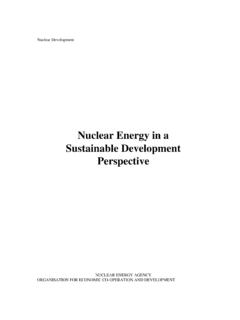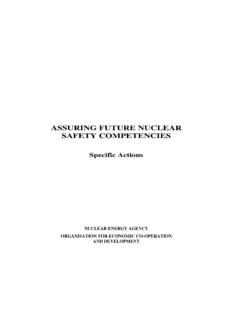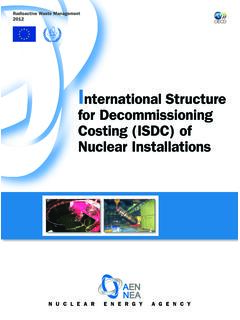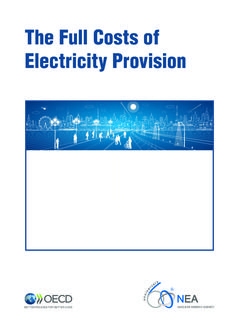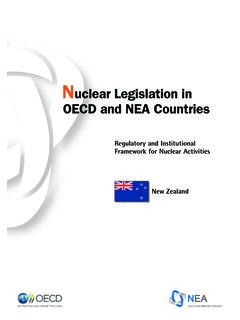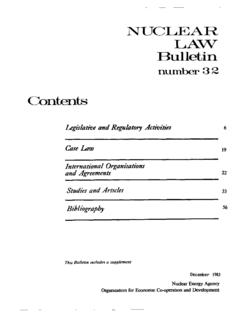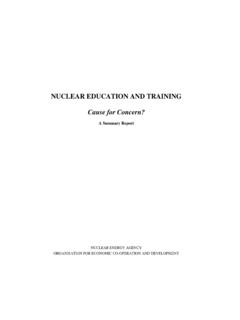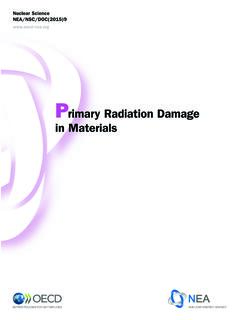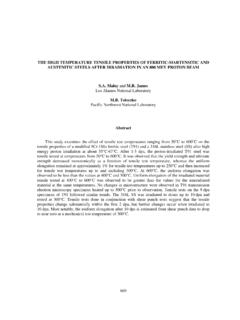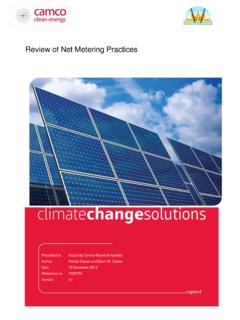Transcription of Preparing for Decommissioning During Operation …
1 Preparing for Decommissioning During Operation and After Final ShutdownRadioactive Waste Management and Decommissioning 2018 Radioactive Waste Management and Decommissioning Preparing for Decommissioning During Operation and After Final Shutdown OECD 2018 NEA No. 7374 NUCLEAR ENERGY AGENCY ORGANISATION FOR ECONOMIC CO- Operation AND DEVELOPMENT ORGANISATION FOR ECONOMIC CO- Operation AND DEVELOPMENT The OECD is a unique forum where the governments of 35 democracies work together to address the economic, social and environmental challenges of globalisation.
2 The OECD is also at the forefront of efforts to understand and to help governments respond to new developments and concerns, such as corporate governance, the information economy and the challenges of an ageing population. The Organisation provides a setting where governments can compare policy experiences, seek answers to common problems, identify good practice and work to co-ordinate domestic and international policies. The OECD member countries are: Australia, Austria, Belgium, Canada, Chile, the Czech Republic, Denmark, Estonia, Finland, France, Germany, Greece, Hungary, Iceland, Ireland, Israel, Italy, Japan, Korea, Latvia, Luxembourg, Mexico, the Netherlands, New Zealand, Norway, Poland, Portugal, the Slovak Republic, Slovenia, Spain, Sweden, Switzerland, Turkey, the United Kingdom and the United States.
3 The European Commission takes part in the work of the OECD. OECD Publishing disseminates widely the results of the Organisation s statistics gathering and research on economic, social and environmental issues, as well as the conventions, guidelines and standards agreed by its members. This work is published on the responsibility of the Secretary-General of the OECD. NUCLEAR ENERGY AGENCY The OECD Nuclear Energy Agency (NEA) was established on 1 February 1958. Current NEA membership consists of 33 countries: Argentina, Australia, Austria, Belgium, Canada, the Czech Republic, Denmark, Finland, France, Germany, Greece, Hungary, Iceland, Ireland, Italy, Japan, Korea, Luxembourg, Mexico, the Netherlands, Norway, Poland, Portugal, Romania, Russia, the Slovak Republic, Slovenia, Spain, Sweden, Switzerland, Turkey, the United Kingdom and the United States.
4 The European Commission and the International Atomic Energy Agency also take part in the work of the Agency. The mission of the NEA is: to assist its member countries in maintaining and further developing, through international co- Operation , the scientific, technological and legal bases required for a safe, environmentally sound and economical use of nuclear energy for peaceful purposes; to provide authoritative assessments and to forge common understandings on key issues as input to government decisions on nuclear energy policy and to broader OECD analyses in areas such as energy and the sustainable development of low-carbon economies.
5 Specific areas of competence of the NEA include the safety and regulation of nuclear activities, radioactive waste management and Decommissioning , radiological protection, nuclear science, economic and technical analyses of the nuclear fuel cycle, nuclear law and liability, and public information. The NEA Data Bank provides nuclear data and computer program services for participating countries. This document, as well as any data and map included herein, are without prejudice to the status of or sovereignty over any territory, to the delimitation of international frontiers and boundaries and to the name of any territory, city or area.
6 Corrigenda to OECD publications may be found online at: OECD 2018 You can copy, download or print OECD content for your own use, and you can include excerpts from OECD publications, databases and multimedia products in your own documents, presentations, blogs, websites and teaching materials, provided that suitable acknowledgement of the OECD as source and copyright owner is given. All requests for public or commercial use and translation rights should be submitted to Requests for permission to photocopy portions of this material for public or commercial use shall be addressed directly to the Copyright Clearance Center (CCC) at or the Centre fran ais d'exploitation du droit de copie (CFC) Cover photos: Whiteshell Laboratories (Provided courtesy of CNL).
7 FOREWORD Preparing FOR Decommissioning During Operation AND AFTER FINAL SHUTDOWN, NEA No. 7374, OECD 2018 3 Foreword The transition from an operating nuclear facility to the implementation of the dismantling phase is critical in every Decommissioning project. A number of organisational and technical modifications are needed to adapt the facility so that it can meet new objectives and requirements. A variety of activities need to be planned and performed both to support the transition and to prepare the dismantling of the facility.
8 Experience has shown that it is essential to start with preparations for Decommissioning at a very early stage, at best already During the design stage of the facility, and at least During the operational stage. The preparation of the transition to Decommissioning and dismantling (D&D) is a key issue for the success of the global D&D project in order to minimise delays and undue costs; to optimise personnel and other resources; and to initiate preparatory activities for Decommissioning in a planned, timely and cost-effective manner, with the overall objective of ensuring safe and efficient Decommissioning .
9 With a growing number of nuclear facilities reaching the Decommissioning stage, the Working Party on Decommissioning and Dismantling (WPDD) formed the Task Group on Preparing for Decommissioning During Operation and after Final Shutdown (TGPFD), which involves regulators, nuclear operators and independent experts who review strategic aspects to optimise preparations for Decommissioning from the last years of Operation onwards. The present report summarises work carried out by TGPFD between March 2015 and December 2017. It supports ongoing and new Decommissioning projects by providing observations and recommendations relating to the development and optimisation of strategies, as well as plans to prepare for the Decommissioning of nuclear facilities.
10 In doing so, it ensures value for money, safety of workers and improvements in project management consistent with good practices and the timely delivery of Decommissioning targets. Rather than providing detailed descriptions of the relevant methods or technologies, the report focuses on strategic approaches, different issues that might arise, risks and observations of good practice. ACKNOWLEDGEMENTS 4 Preparing FOR Decommissioning During Operation AND AFTER FINAL SHUTDOWN, NEA No. 7374, OECD 2018 Acknowledgements The NEA would like to thank the following contributors for their review and drafting of the report.
